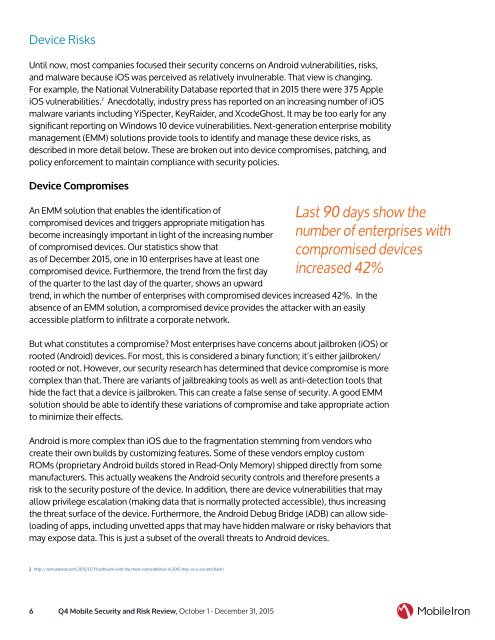Q4 Mobile Security and Risk Review
security-report-Q415-v1.2-EN
security-report-Q415-v1.2-EN
Create successful ePaper yourself
Turn your PDF publications into a flip-book with our unique Google optimized e-Paper software.
Device <strong>Risk</strong>s<br />
Until now, most companies focused their security concerns on Android vulnerabilities, risks,<br />
<strong>and</strong> malware because iOS was perceived as relatively invulnerable. That view is changing.<br />
For example, the National Vulnerability Database reported that in 2015 there were 375 Apple<br />
iOS vulnerabilities. 2<br />
Anecdotally, industry press has reported on an increasing number of iOS<br />
malware variants including YiSpecter, KeyRaider, <strong>and</strong> XcodeGhost. It may be too early for any<br />
significant reporting on Windows 10 device vulnerabilities. Next-generation enterprise mobility<br />
management (EMM) solutions provide tools to identify <strong>and</strong> manage these device risks, as<br />
described in more detail below. These are broken out into device compromises, patching, <strong>and</strong><br />
policy enforcement to maintain compliance with security policies.<br />
Device Compromises<br />
Last 90 days show the<br />
number of enterprises with<br />
compromised devices<br />
increased 42%<br />
An EMM solution that enables the identification of<br />
compromised devices <strong>and</strong> triggers appropriate mitigation has<br />
become increasingly important in light of the increasing number<br />
of compromised devices. Our statistics show that<br />
as of December 2015, one in 10 enterprises have at least one<br />
compromised device. Furthermore, the trend from the first day<br />
of the quarter to the last day of the quarter, shows an upward<br />
trend, in which the number of enterprises with compromised devices increased 42%. In the<br />
absence of an EMM solution, a compromised device provides the attacker with an easily<br />
accessible platform to infiltrate a corporate network.<br />
But what constitutes a compromise? Most enterprises have concerns about jailbroken (iOS) or<br />
rooted (Android) devices. For most, this is considered a binary function; it’s either jailbroken/<br />
rooted or not. However, our security research has determined that device compromise is more<br />
complex than that. There are variants of jailbreaking tools as well as anti-detection tools that<br />
hide the fact that a device is jailbroken. This can create a false sense of security. A good EMM<br />
solution should be able to identify these variations of compromise <strong>and</strong> take appropriate action<br />
to minimize their effects.<br />
Android is more complex than iOS due to the fragmentation stemming from vendors who<br />
create their own builds by customizing features. Some of these vendors employ custom<br />
ROMs (proprietary Android builds stored in Read-Only Memory) shipped directly from some<br />
manufacturers. This actually weakens the Android security controls <strong>and</strong> therefore presents a<br />
risk to the security posture of the device. In addition, there are device vulnerabilities that may<br />
allow privilege escalation (making data that is normally protected accessible), thus increasing<br />
the threat surface of the device. Furthermore, the Android Debug Bridge (ADB) can allow sideloading<br />
of apps, including unvetted apps that may have hidden malware or risky behaviors that<br />
may expose data. This is just a subset of the overall threats to Android devices.<br />
2 http://venturebeat.com/2015/12/31/software-with-the-most-vulnerabilities-in-2015-mac-os-x-ios-<strong>and</strong>-flash/<br />
6 <strong>Q4</strong> <strong>Mobile</strong> <strong>Security</strong> <strong>and</strong> <strong>Risk</strong> <strong>Review</strong>, October 1 - December 31, 2015






